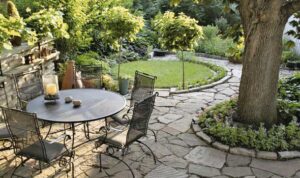
The retrofit approach
As climate change drives increasingly frequent and intense heatwaves across the UK, keeping our homes cool has become a growing concern. However, the traditional approach of using air conditioning and relying on artificial cooling methods is not only energy-intensive but also environmentally unsustainable.
As we are all committed to reducing our carbon footprint and living in harmony with nature, it’s good to know that there are greener, more ecological ways to keep our homes cool during a heatwave.
In this Blog, I explore the sustainable strategies that focus on making your home and garden work with nature to create a cooler, more comfortable environment during the hottest months of the year.
Keeping it green – inside and out
Retrofitting is about adapting your existing home to become more energy-efficient, sustainable and environmentally friendly. It’s a way of modernising your living space while reducing its ecological impact. In the context of keeping your house cool, this involves enhancing natural ventilation, improving insulation, and integrating eco-friendly materials and technologies. By adopting these practices, you can create a cool sanctuary during heatwaves without compromising on your commitment to the environment.
1. Enhancing natural ventilation
Natural ventilation is one of the most effective ways to cool your home without relying on energy-intensive air conditioning. By maximising airflow and using passive cooling techniques, you can significantly reduce indoor temperatures.
Maximise cross-ventilation
Strategic window placement - if you're considering window replacements or upgrades, think about how the placement of windows can enhance cross-ventilation. Install windows on opposite sides of the house to allow cool air to flow through and hot air to escape. For an existing home, you can enhance this effect by opening windows on opposite sides during cooler parts of the day.
Ventilation grilles and vents - consider adding ventilation grilles or vents above internal doors to allow air to circulate more freely between rooms. This can help maintain a steady flow of cooler air throughout the house.
Use stack ventilation
Install roof vents or skylights - hot air rises, and by installing roof vents or skylights that can be opened, you can allow the hot air to escape naturally. This method, known as stack ventilation, encourages cooler air to flow in from lower levels of the house, effectively lowering indoor temperatures.
Solar chimneys - a solar chimney is a vertical shaft that uses solar energy to enhance natural ventilation. The sun heats the air inside the chimney, causing it to rise and exit the top, which draws cooler air into the home from the lower levels. Solar chimneys are an excellent retrofit option for reducing heat without increasing your energy consumption.
2. Shading and Insulation
One of the most sustainable ways to keep your home cool is by preventing heat from entering in the first place. By using natural shading, reflective materials, and eco-friendly insulation, you can create a more comfortable indoor environment that remains cool even during the peak of a heatwave.
Natural shading solutions
Planting trees and shrubs – these can be strategically planted to provide natural shade for your home, reducing the amount of direct sunlight that hits your walls and windows. Deciduous trees, which lose their leaves in winter, are particularly effective because they provide shade in the summer, while allowing sunlight to warm your home in the winter.
Green roofs - installing a green roof is an excellent way to insulate your home naturally. A green roof is covered with vegetation that not only provides shade but also cools the air through evapotranspiration. This process, where plants release moisture into the air, can significantly reduce the temperature of the roof surface, keeping the rooms below cooler.
Living walls - similar to green roofs, living walls (also known as green walls) are vertical gardens that can be attached to the exterior walls of your home. They offer natural insulation and cooling benefits, as well as improving air quality and biodiversity around your home.
Eco-friendly insulation
Natural insulation materials - retrofitting your home with eco-friendly insulation materials, such as sheep’s wool, hemp, or cellulose, can help maintain a consistent indoor temperature. These materials are not only effective at keeping heat out in the summer, but also at retaining warmth during the winter, making them a year-round sustainable solution.
Cool roof technology - if your roof is due for an upgrade, consider installing cool roof materials that reflect more sunlight and absorb less heat than standard roofing. This can significantly reduce the amount of heat that enters your home. For an even greener option, look for cool roof materials made from recycled or sustainably sourced materials.
Reflective window treatments
Reflective films - applying reflective window films is an easy retrofit solution that can reduce solar heat gain while still allowing natural light into your home. These films are particularly effective on south- and west-facing windows, which receive the most direct sunlight.
External shutters and shades - external shutters, shades, or even simple awnings can block out the sun’s rays before they hit your windows, preventing the greenhouse effect that occurs when sunlight heats up indoor spaces. Look for sustainable materials, such as bamboo or reclaimed wood, to enhance the eco-friendliness of these features.
3. Eco-conscious garden design
Your garden can play a crucial role in keeping your home cool. By designing your outdoor space with cooling and sustainability in mind, you can create a microclimate that reduces the overall temperature around your home.
Xeriscaping
Drought-resistant plants - xeriscaping is a landscaping method that focuses on using drought-resistant plants, which require minimal water and can withstand high temperatures. By choosing plants that thrive in hot, dry conditions, you reduce the need for watering and create a garden that can survive and even thrive during a heatwave.
Mulching - use organic mulch around your plants and garden beds to retain moisture and keep the soil cool. Mulching also reduces the need for watering, conserves soil health, and prevents weeds, making it an all-around sustainable gardening practice.
Water features
Natural water features - a pond or fountain can have a cooling effect on your garden by adding moisture to the air and lowering the surrounding temperature. To maintain ecological balance, consider using a solar-powered pump to circulate the water and avoid chemicals that could harm local wildlife.
Rainwater harvesting - collect rainwater using barrels or an underground cistern to water your garden during dry spells. This not only reduces your dependence on mains water but also ensures that your garden remains lush and cool, even during a heatwave.
Vertical gardens and pergolas
Vertical Gardens - vertical gardens, or green walls, can be installed in your garden to provide shade and cool the air around your home. They can be planted with a variety of species, including herbs, flowers, and climbing plants, to create a beautiful, functional feature that contributes to a cooler microclimate.
Pergolas with climbing plants - a pergola covered with climbing plants like ivy, wisteria, or grapevines can provide much-needed shade for outdoor areas. This not only creates a cool space for you to enjoy but also reduces the heat absorbed by the walls of your home.
Renewable energy integration
Solar panels - while solar panels primarily generate electricity, they can also play a role in keeping your home cool by powering fans, pumps, or even a small air conditioning unit. By generating your own renewable energy, you reduce your reliance on the grid and lower your carbon footprint.
Solar-powered ventilation - installing solar-powered ventilation systems can enhance airflow and keep your home cool, without increasing your energy bills. These systems use solar energy to power fans that draw cool air in and expel hot air, making them a sustainable retrofit solution.
Water conservation systems
Greywater recycling - implementing a greywater recycling system allows you to reuse water from showers, baths and sinks to irrigate your garden. This not only reduces your water consumption but also ensures that your garden remains green and cool during dry periods.
Permeable paving - if you’re considering a new patio or driveway, opt for permeable paving materials that allow rainwater to seep into the ground rather than run off. This helps to cool the surrounding environment and supports groundwater recharge.
So, why not embrace the power of natural ventilation, sustainable shading and green gardening practices to keep your house cool during a heatwave… all while staying committed to a greener, more sustainable future.
Carl Dodd, Property Revolutions Ltd.

